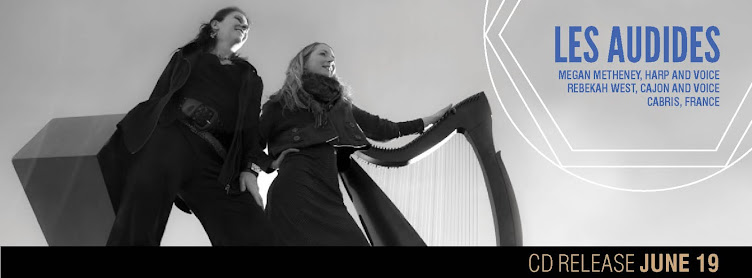 |
‘Tis Autumn with Cy Todd, concert in Biot chez Terry, October 24, 2010 |
Two tunes here. Both written in the 40’s. Both inspired by autumn. Each in a totally different mood (heartbreaking vs. cheerful). Both lovable. Both lovely on the harp.
Les Feuilles Mortes/ Autumn Leaves
French lyrics by Jacques Prévert, English lyrics by Johnny Mercer, Music by Joseph Kosma
1945
The falling leaves drift by the window
The autumn leaves of red and gold
I see your lips, the summer kisses
The sun-burned hands I used to hold
Since you went away the days grow long
And soon I'll hear old winter's song
But I miss you most of all my darling
When autumn leaves start to fall
Oh! je voudrais tant que tu te souviennes
Des jours heureux où nous étions amis
En ce temps-là la vie était plus belle,
Et le soleil plus brûlant qu'aujourd'hui
Les feuilles mortes se ramassent à la pelle
Tu vois, je n'ai pas oublié...
Les feuilles mortes se ramassent à la pelle,
Les souvenirs et les regrets aussi
Et le vent du nord les emporte
Dans la nuit froide de l'oubli.
Tu vois, je n'ai pas oublié
La chanson que tu me chantais.
C'est une chanson qui nous ressemble
Toi, tu m'aimais et je t'aimais
Et nous vivions tous deux ensemble
Toi qui m'aimais, moi qui t'aimais
Mais la vie sépare ceux qui s'aiment
Tout doucement, sans faire de bruit
Et la mer efface sur le sable
Les pas des amants désunis.
Les feuilles mortes se ramassent à la pelle,
Les souvenirs et les regrets aussi
Mais mon amour silencieux et fidèle
Sourit toujours et remercie la vie
Je t'aimais tant, tu étais si jolie,
Comment veux-tu que je t'oublie?
En ce temps-là, la vie était plus belle
Et le soleil plus brûlant qu'aujourd'hui
Tu étais ma plus douce amie
Mais je n'ai que faire des regrets
Et la chanson que tu chantais
Toujours, toujours je l'entendrai!
* * * * * * * * * * * * * * * * * *
‘Tis Autumn by Henry Nemo
1941
Old Father time checked, so there'd be no doubt;
Called on the North wind to come on out,
Then cupped his hands so proudly to shout,
"La-di-dah di-dah-di-dum, 'tis autumn!"
Trees say they're tired, they've born too much fruit;
Charmed on the wayside, there's no dispute.
Now shedding leaves, they don't give a hoot -
La-di-dah di-dah-di-dum, 'tis autumn!
Then the birds got together to chirp about the weather
Mmmm-mmm-mmm-mmm.
After makin' their decision, in birdie-like precision,
Turned about, and made a beeline to the south.
My holding you close really is no crime -
Ask the birds and the trees and old Father Time.
It's just to help the mercury climb.
La-di-dah di-dah-di-dum, 'tis autumn.
* * * * * * * * * * * * * * * * * *
This past weekend, my friend Terry hosted me in concert at her lovely home. It was so nice to try out some of these pieces I’ve been working on. Terry and another friend, Cy, sang Les Feuilles Mortes and ‘Tis Autumn. Several people shared poetry about Autumn.
Most of the guests were native English-speakers from various parts of the planet. All of them had a different regard for Autumn... sad, colorful, cheery, or depressing, etc. That’s what I’m finding for each of the Autumn pieces- Autumn to one composer means something very different to another. Which makes this project interesting....
To Mr./Mrs. Composer: What does Autumn sound like to you? How would you express Autumn through the medium of music?
...it’s a scientific-like research and dissection. But for fun, and definitely not sterile- I get to dirty my hands in my own interpretation of each composition.
It’s a coordination of:
Art = “The expression or application of human skill and imagination, producing works to be appreciated primarily for their beauty or emotional power.”
Autumn = “The third season of the year, when crops and fruits are gathered and leaves fall, in the Northern Hemisphere from September to November and in the Southern Hemisphere from March to May.”
Therefore, my confirmed hypothesis at this juncture is: um.






